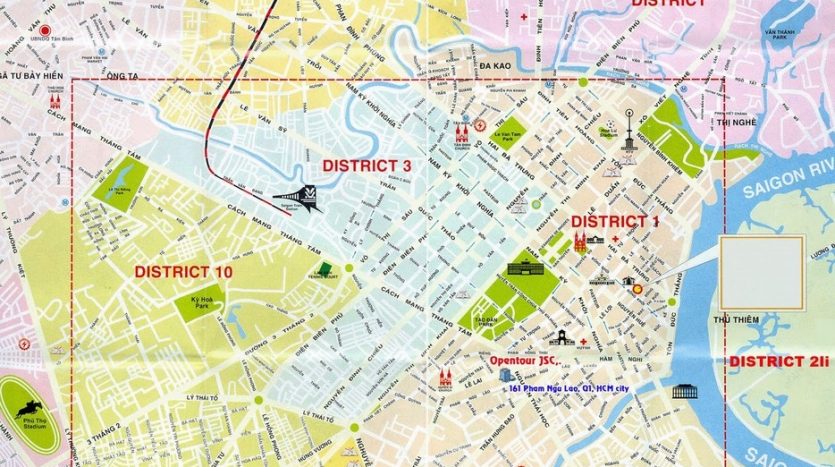When looking for a new house or apartment in Saigon it pays to consider where best to live. Some expatriates work at industrial zones far outside the city, but this can lead to isolation so many decide to put up with a long commute in order to improve their social options.
Likewise while some expatriates relish the opportunity to discover and immerse themselves in a new culture, for others it is more important to live in familiar surroundings with similar facilities to those they left at home. Nobody likes to commute and traffic in Saigon can be pretty horrific, so its not a bad idea to think about where you will be working or your kids will be attending school too.
In general most people have a choice between going for the all-out expat experience in District 2 or District 7, where life is more like home than Vietnam proper, or diving into the entertaining chaos that makes up the city centre and outlying districts. Here is a brief overview of the districts of Saigon and the atmosphere and facilities you can expect in each area
District 1
District 1 is the central business district of Ho Chi Minh City, where many companies will base their offices and where the majority of bars and restaurants are. Although rising rents have pushed a lot of the simpler local street food and restaurants out, there remains a wide range of eating options with cuisines from around the world, and shops bringing goods from across the world for those who enjoy their shopping. While District 1 certainly has a different atmosphere to much of the city, it is still uniquely Vietnamese in character.
The streets in District 1 are broad and generally tree-lined, and although it is the city centre the traffic is generally worse entering or leaving District 1 than within the district itself, so if you can afford to live in the centre or like the bright lights of the city it can make an excellent choice to settle in.
District 2 – An Phu / Thao Dien
District 2 is a huge area, much of which is currently undeveloped marsh land, so generally when expats refer to District 2 they are talking about An Phu and Thao Dien wards, where much of Saigon’s western expatriates settle, as well as wealthy Vietnamese.
Despite being split in two by the massive Highway 1, the roads around An Phu/Thao Dien are fairly peaceful and not too scary to negotiate by bicycle. Many of the houses here are very large – villas with pools designed for those whose housing is included in their contracts – and some are within walled compounds – but there are still affordable houses available for rent. The number of eating and drinking options in An Phu is growing, with a number of nice bars, riverside cafes and shops, which is a good thing since the commute to District 1 is generally around 30-40 minutes, and there are several major international schools and nurseries in the area.
An Phu is certainly a friendly area, referred to as ‘the village’ by residents, and while some may find it rather Westernised and a little far removed from a genuine Saigon experience, others will relish the peace and quiet and safety it provides for their children.
District 7 – Phu My Hung / Saigon South
The massive Korean Phu My Hung development, around 40 minutes to the south of District 1, was conceived as a ‘satellite city’ for Ho Chi Minh, and has been designed from scratch with wide, tree lined roads and towering apartment blocks and villas. So far there is little other development in the area which means unparallelled access to green space, and there are a number of sports clubs, swimming pools, and international schools and universities in the area.
There are many expatriates living here, the biggest group of which are East Asians such as Koreans and Japanese, but there are a growing number of Western expatriates too. The area used to recieve a bad rap for being something of a ‘toy town’ – the area certainly appears sterile when compared to some of the inner city areas with little to no street life and a small but growing number of shops and restaurant, but over the years it has become a more lively place, and in the late afternoons being able to sit on the grass and appreciate the breeze is great after a hot day in the city.
District 7 is certainly not your typical Vietnamese experience, but if you can’t take the noise and chaos of the centre or wish to raise your kids with a bit of space to run around it is not a bad option.
District 3
District 3 is considered by many Vietnamese people to be the ideal place to live , with large, old colonial villas hidden behind trees, great proximity to District 1 and a decent quality of life. It is less ‘westernised’ than District 1, but compared to much of central Saigon is a very peaceful place with lots of local places to eat.
One popular Vietnamese expression statesyou should go out in District 1, eat in District 5 but sleep in District 3. It certainly has many beautiful buildings but many have been adopted by the government while others are in varying states of repair – for villas in good condition expect to pay a rather high rent, but there are also plenty of townhouses in the area too.
District 4
District 4 used to be known as the ‘mafia district’ – housing Saigon’s main port and many of the city’s poor gave plenty of opportunity for crime. This seems to be a thing of the past, and improving transport links to District 1 has seen a recent bump in land prices as more and more apartment blocks for executives are built – in some places a commute into Downtown District 1 might only take 5 minutes, and rents are much cheaper than District 1. The Saigon port is set to close in years to come and the whole area is due for redevelopment – perhaps in coming years it will have a similar amount of restaurants and shops to District 1, but for now it is more of a throughfare between Districts 1 and 7.
District 5
District 5 is a good choice for those seeking proximity to District 1 – commutes range from 10 – 20 minutes, with lower congestion than some routes into the city, but with lower rents. District 5 is famed for its street food, and its history as the city’s Chinatown means there is a fair mix of cuisines in the area.
District 10
District 10 is traditionally where many of Saigon’s student population live, with great, cheap options for food and good, low rents. The area is very densely populated though and has quite narrow streets so traffic in and out of the centre can be a pain, but as the crow flies it is not far to the downtown area. The area is also rich in amenities, with lots of swimming pools and sports centres to suit the student population, as well as a good number of coffeeshops.
Phu Nhuan
Phu Nhuan is one of the most densely populated areas of Saigon and has a number of main roads running through it. The area is certainly not without its charms with a number of parks and interesting streetlife, but traffic to and from the centre can get pretty tiresome quickly. Still, if you work in the E Town area in Tan Binh, or anywhere near the airport, living in Phu Nhuan can be a good option to be near work yet not too far from social activites in town.
Binh Thanh
Binh Than is squeezed between District 1 and District 2, and is known for cheap housing that is popular among English teachers on low wages. However the area has seen near constant roadworks for over 3 years, and is the primary point of entry for hundreds of HGV trucks that pour into the city every night. It is also very prone to flooding, even on the main roads, making driving around at night a fairly scary prospect and offering very low air quality, with dust from construction and trucks mingling with diesel fumes.


